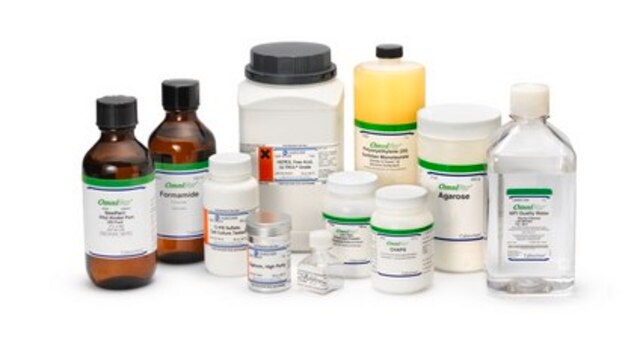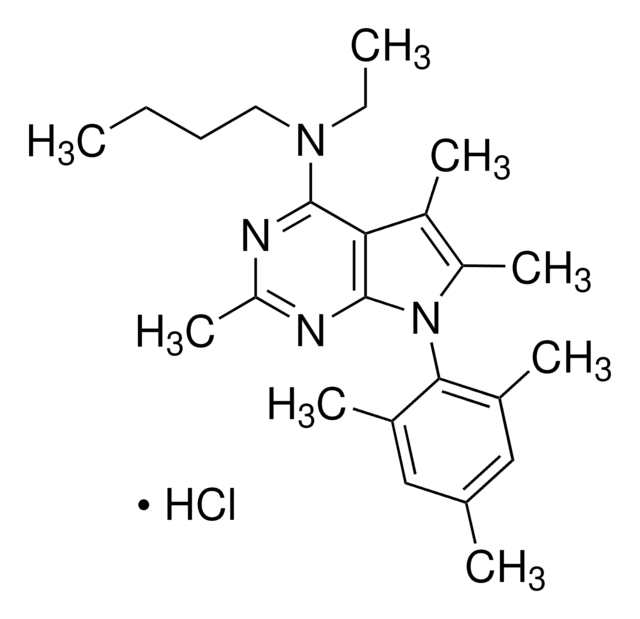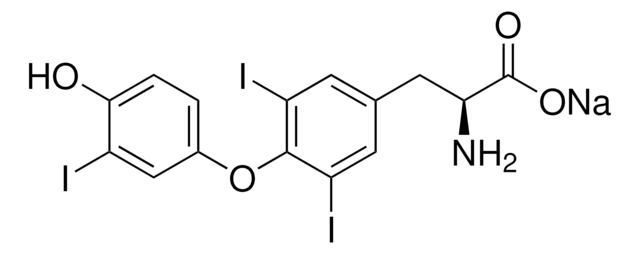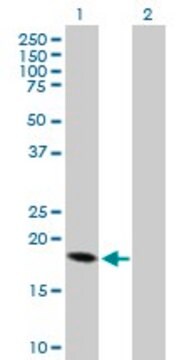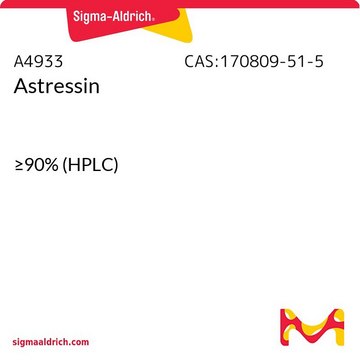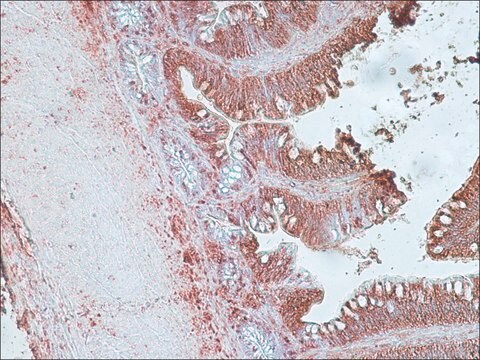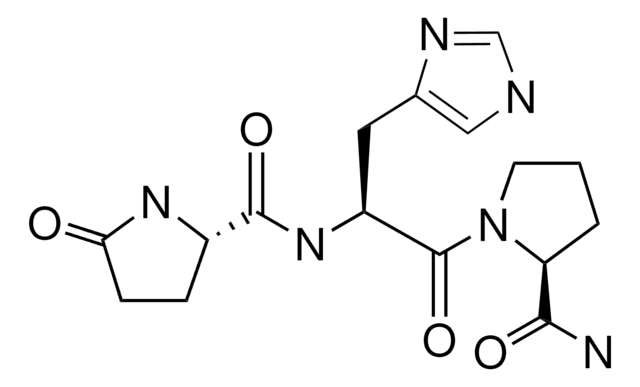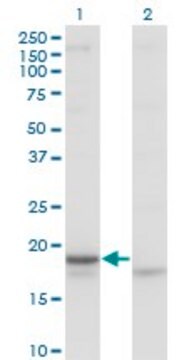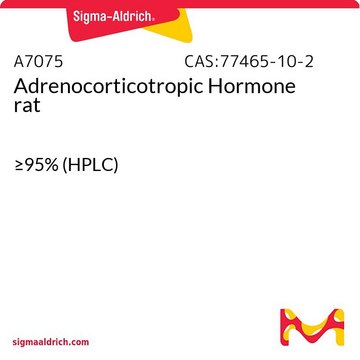C3042
Corticotropin Releasing Factor human, rat
≥95% (HPLC), powder
Synonim(y):
CRF, CRH
Zaloguj sięWyświetlanie cen organizacyjnych i kontraktowych
About This Item
Wzór empiryczny (zapis Hilla):
C208H344N60O63S2
Numer CAS:
Masa cząsteczkowa:
4757.45
Numer MDL:
Kod UNSPSC:
12352200
NACRES:
NA.32
Polecane produkty
pochodzenie biologiczne
human
rat
Poziom jakości
Próba
≥95% (HPLC)
Formularz
powder
masa cząsteczkowa
4757.45
warunki przechowywania
(Keep container tightly closed in a dry and well-ventilated place)
metody
activity assay: suitable
rozpuszczalność
water: 1.00-1.04 mg/mL, colorless
numer dostępu UniProt
temp. przechowywania
−20°C
Klucz InChI
VXFVFWFSJFSXHN-FAUHKOHMSA-N
informacje o genach
human ... CRH(1392)
Szukasz podobnych produktów? Odwiedź Przewodnik dotyczący porównywania produktów
Amino Acid Sequence
Ser-Glu-Glu-Pro-Pro-Ile-Ser-Leu-Asp-Leu-Thr-Phe-His-Leu-Leu-Arg-Glu-Val-Leu-Glu-Met-Ala-Arg-Ala-Glu-Gln-Leu-Ala-Gln-Gln-Ala-His-Ser-Asn-Arg-Lys-Leu-Met-Glu-Ile-Ile-NH2
Opis ogólny
The corticotropin-releasing factor is a 41-amino-acid polypeptide. It is expressed in neurons, the hypothalamus, and the amygdala.
Research area: Neuroscience
Research area: Neuroscience
Zastosowanie
Corticotropin Releasing Factor human, rat has been used:
- as a component in Dulbecco′s modified eagle medium (DMEM) for incubating lung explants
- as a component in serum-free complete medium for isolation and culturing of fetal distal lung epithelial cells
- in the synthesis of the corticotropin-releasing factor(CRF)-TAMRA 1 mixture
- in chronic intracerebroventicular administration, to study its effect on hypoxia in hippocampus
Działania biochem./fizjol.
CRF is a hypothalamic peptide that releases ACTH and endorphin from the anterior pituitary. It is also a neurotransmitter in the central nervous system, and is involved in autonomic and endocrine responses to stress.
Corticotropin-releasing factor modulates stress responses. It facilitates stress-stimulated activation of the hypothalamic−pituitary−adrenal system.Corticotropin Releasing Factor/hormone (CRF/H) at higher levels has been observed in stress-related physiological and behavioral disorders. It has been involved in anxiety and depression disorders. Under stress conditions, the release of CRH activates the corticotrophin-releasing hormone receptor type I (CRHR1) in the anterior pituitary for the release of adrenocorticotropic hormone (ACTH) that further stimulates the production/secretion of cortisol/corticosterone.
Releases ACTH and endorphin from the anterior pituitary; central nervous system neurotransmitter.
Inne uwagi
Lyophilized from 0.1% TFA in H2O
Ta strona może zawierać tekst przetłumaczony maszynowo.
przeciwciało
Numer produktu
Opis
Cennik
Kod klasy składowania
11 - Combustible Solids
Klasa zagrożenia wodnego (WGK)
WGK 3
Temperatura zapłonu (°F)
Not applicable
Temperatura zapłonu (°C)
Not applicable
Środki ochrony indywidualnej
Eyeshields, Gloves, type N95 (US)
Wybierz jedną z najnowszych wersji:
Masz już ten produkt?
Dokumenty związane z niedawno zakupionymi produktami zostały zamieszczone w Bibliotece dokumentów.
Klienci oglądali również te produkty
Anxiolytics.
Handbook of Clinical Neurophysiology, 106, 669-669 (2012)
Frameworks of alcohol addiction: alcohol addiction as a reward deficit and stress surfeit disorder
Frontiers in Psychiatry, 3-28 (2014)
Transcriptional regulation of hypothalamic corticotropin-releasing factor gene
Vitamins & Hormones, 82, 301-317 (2010)
Identification of brain target neurons using a fluorescent conjugate of corticotropin-releasing factor
Hubbard CS, et al.
Journal of Chemical Neuroanatomy, 37(4), 245-253 (2009)
Colette G Ngo Ndjom et al.
Frontiers in microbiology, 6, 279-279 (2015-04-24)
Streptococcus pneumoniae (S. pneumoniae), a commensal across the nasal passages, is responsible for the majority of infectious pneumonia cases worldwide. Previous studies have shown that hormonal factors may be influential in regulating S. pneumoniae's transition from a non-pathogen to a
Nasz zespół naukowców ma doświadczenie we wszystkich obszarach badań, w tym w naukach przyrodniczych, materiałoznawstwie, syntezie chemicznej, chromatografii, analityce i wielu innych dziedzinach.
Skontaktuj się z zespołem ds. pomocy technicznej